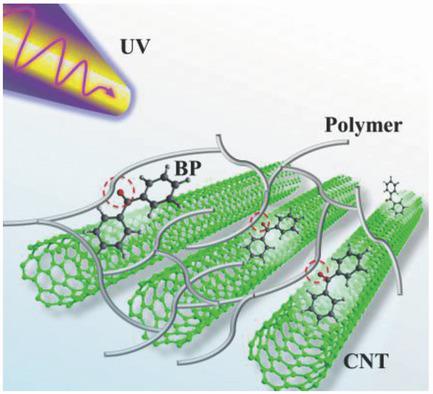当前位置:
X-MOL 学术
›
Adv. Mater. Interfaces
›
论文详情
Our official English website, www.x-mol.net, welcomes your
feedback! (Note: you will need to create a separate account there.)
Light‐Responsive Chemistry to Enable Tunable Interface‐Dependent Mechanical Properties in Composites
Advanced Materials Interfaces ( IF 4.3 ) Pub Date : 2018-04-03 , DOI: 10.1002/admi.201800038 Frank Gardea 1 , Zhongjie Huang 2 , Bryan Glaz 1 , Shashi P. Karna 3 , Xiyuan Cheng 2 , Zhiwei Peng 2 , YuHuang Wang 2, 4
Advanced Materials Interfaces ( IF 4.3 ) Pub Date : 2018-04-03 , DOI: 10.1002/admi.201800038 Frank Gardea 1 , Zhongjie Huang 2 , Bryan Glaz 1 , Shashi P. Karna 3 , Xiyuan Cheng 2 , Zhiwei Peng 2 , YuHuang Wang 2, 4
Affiliation

|
This work shows the potential of using stimuli‐responsive interfacial adhesion as a means to control interface‐dependent properties in nanocomposites, which could enable interesting applications, such as remote shaping of structural materials, adaptive soft robotics, and tunable intrinsic material damping. In this approach, covalent interfacial bonding is triggered by exposure to an ultraviolet light stimulus, while the degree of interfacial interaction is varied with irradiation duration. To demonstrate the applicability of the technique, polydimethylsiloxane (PDMS) is considered with carbon nanotube (CNT) fillers functionalized with the photoreactive molecule benzophenone. For this specific exemplar material system, the elastic modulus increases by as much as 93%, along with substantial increases in yield stress. The variation with irradiation time is shown to provide the high degree of spatial control needed to engineer heterogeneous materials with desired behavior. While the technique developed in this work is demonstrated on a CNT/PDMS system, the chemistry is generally applicable to a variety of organic filler/matrix combinations, expanding the utility of this interfacial control method to a wide range of material systems. Due to the amenability of this approach to layer‐by‐layer construction, this work shows the potential as an additive manufacturing technique for engineering materials on‐demand with necessary heterogeneous make‐ups.
中文翻译:

光响应化学可实现复合材料中可调节的界面相关的机械性能
这项工作表明了使用刺激响应界面粘附作为控制纳米复合材料界面依赖特性的手段的潜力,这可以实现有趣的应用,例如结构材料的远程成形,自适应软机器人和可调的固有材料阻尼。在这种方法中,共价界面键是通过暴露于紫外线刺激而触发的,而界面相互作用的程度则随照射时间的长短而变化。为了证明该技术的适用性,考虑将聚二甲基硅氧烷(PDMS)与被光反应性分子二苯甲酮官能化的碳纳米管(CNT)填料一起使用。对于这种特定的示例材料系统,弹性模量增加了93%,同时屈服应力也大大增加。结果表明,随照射时间的变化可提供高度空间控制,以对具有所需行为的异质材料进行工程处理。虽然在CNT / PDMS系统上证明了这项工作中开发的技术,但该化学方法通常适用于各种有机填料/基体组合,从而将这种界面控制方法的实用性扩展到了广泛的材料系统中。由于这种方法适用于逐层构造,因此这项工作显示了作为增材制造技术的潜力,该增材制造技术可按需添加具有必要异质组成的工程材料。这种化学方法通常适用于各种有机填料/基体组合,从而将这种界面控制方法的实用性扩展到了广泛的材料系统中。由于这种方法适用于逐层构造,因此这项工作显示了作为增材制造技术的潜力,可以按需添加具有必要的异质结构的工程材料。这种化学方法通常适用于各种有机填料/基体组合,从而将这种界面控制方法的实用性扩展到了广泛的材料系统中。由于这种方法适用于逐层构造,因此这项工作显示了作为增材制造技术的潜力,可以按需添加具有必要的异质结构的工程材料。
更新日期:2018-04-03
中文翻译:

光响应化学可实现复合材料中可调节的界面相关的机械性能
这项工作表明了使用刺激响应界面粘附作为控制纳米复合材料界面依赖特性的手段的潜力,这可以实现有趣的应用,例如结构材料的远程成形,自适应软机器人和可调的固有材料阻尼。在这种方法中,共价界面键是通过暴露于紫外线刺激而触发的,而界面相互作用的程度则随照射时间的长短而变化。为了证明该技术的适用性,考虑将聚二甲基硅氧烷(PDMS)与被光反应性分子二苯甲酮官能化的碳纳米管(CNT)填料一起使用。对于这种特定的示例材料系统,弹性模量增加了93%,同时屈服应力也大大增加。结果表明,随照射时间的变化可提供高度空间控制,以对具有所需行为的异质材料进行工程处理。虽然在CNT / PDMS系统上证明了这项工作中开发的技术,但该化学方法通常适用于各种有机填料/基体组合,从而将这种界面控制方法的实用性扩展到了广泛的材料系统中。由于这种方法适用于逐层构造,因此这项工作显示了作为增材制造技术的潜力,该增材制造技术可按需添加具有必要异质组成的工程材料。这种化学方法通常适用于各种有机填料/基体组合,从而将这种界面控制方法的实用性扩展到了广泛的材料系统中。由于这种方法适用于逐层构造,因此这项工作显示了作为增材制造技术的潜力,可以按需添加具有必要的异质结构的工程材料。这种化学方法通常适用于各种有机填料/基体组合,从而将这种界面控制方法的实用性扩展到了广泛的材料系统中。由于这种方法适用于逐层构造,因此这项工作显示了作为增材制造技术的潜力,可以按需添加具有必要的异质结构的工程材料。









































 京公网安备 11010802027423号
京公网安备 11010802027423号